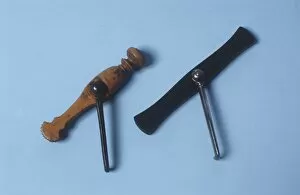Tooth Extractors Collection
"Unveiling the Fascinating World of Tooth Extractors
All Professionally Made to Order for Quick Shipping
"Unveiling the Fascinating World of Tooth Extractors: A Journey through Dental History" Step back in time and explore the intriguing world with these remarkable artifacts from the 19th century. Delve into a collection that showcases the evolution of dental tools, shedding light on early dental practices and their significance in oral health. Amongst this captivating assortment are six tooth keys, each bearing witness to a bygone era. Dating back to the 1800s, these tooth keys (C017 / 8406) were once relied upon for extracting teeth with precision and skill. Imagine the hands that held them, delicately maneuvering within mouths to alleviate pain and discomfort. A dental hygiene set from circa 1820 (C017 / 8395) offers a glimpse into early efforts towards maintaining oral health. These tools served as companions in daily routines, ensuring cleanliness and preventing future complications. The three-clawed tooth key from around 1800 (C017 / 8392) stands as a testament to ingenuity amidst limited resources. Its design allowed dentists to grasp firmly onto stubborn teeth, providing an effective means of extraction even during challenging cases. Witness innovation at its finest with the mechanical tooth key dating back to approximately1850 (C017 /8387). This groundbreaking invention revolutionized dental procedures by introducing mechanical assistance for greater efficiency and reduced patient discomfort. Travel further back in time with a rare find - a dental pincer circa1680 (C017/8383). This ancient tool speaks volumes about early attempts at tackling dental issues while highlighting how far we have come in modern dentistry. Marvel at the pelican tooth extractor from around1750 (C017/8382), which bears resemblance to its namesake bird's beak-like shape. Designed specifically for removing roots intact without causing excessive trauma or damage, it exemplifies delicate craftsmanship combined with practicality.













